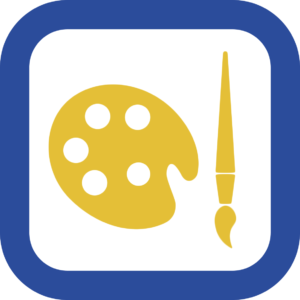
A high-quality art education develops original and inspirational learning leading to a variety of creative interests and career opportunities. Art equips students with inquisitive skills to explore the world around them through close observation and creative thinking. An understanding of the arts and its influence on society nurtures a life-long love and appreciation of the subject. Students investigate a broad range of diverse artists, both contemporary and historical, expanding their cultural and social awareness, which further develops their emotional and cognitive skills. Students are encouraged to experiment with varied techniques to develop their individuality as an artist. The art curriculum actively encourages students to push their potential by building resilience and confidence through success. Students are taught the fundamentals of drawing early in Year 7 to drive creativity and imagination in future projects. The departments focus on the three P’s (practice, patience and perseverance) enables students to make progress.
“To be an artist is to believe in life”- Henry Moore
Year 7
We welcome Year 7 to the Art Department by exploring the ‘Right side of their Brain’. This project is based on the renowned Betty Edwards’ observation drawing exercises. Students acquire good drawing skills by understanding how to observe with careful looking and seeing (developing visual perception). We move onto ‘Animal Portraits’ by painting an animal jungle inspired by Henri Rousseau. An introduction into ‘Surrealism’ encourages students to develop their own ideas about dream-like objects.
Year 8
Drawing is not limited to pencil marks on paper, observations can be recorded in diverse techniques such as paper folding. Students explore a ‘Fabulous Foods’ project, focusing on the technique of colour pencil blending, eventually building up to an origami inspired outcome. The next project is inspired by Pablo Picasso and Georges Braques where students delve into ‘Cubism’. This eventually leads to students beginning to be taught the fundamental and first techniques of portrait drawing using an abstract approach. This step-by-step approach builds resilience and confidence in drawing, ready for realistic portrait drawing in Year 9. Finally, Banksy inspires a ‘Protest’ art project. Where students learn about protest art and its effectiveness and impact on social commentary, designing their own poster.
Projects in Year 7, Year 8 are designed to meet the standards of the National Curriculum as well as prepare students for the next key stage of learning
Year 9
‘Still Life’ welcomes students into their new option choice. We explore a range of current artists and materials, starting with Jane Reynold’s ‘Blocks of Colour’ to Cornelia Parker’s ‘Silver’. Students learn about the transfers of a two-dimensional drawing idea into a three-dimensional form. A ‘Henry Moore’ project allows students to build their understanding of the human form through abstraction. Students then explore abstract forms through their own ideas using the medium of sculpture. Finally, an ‘Icons’ project allows students to start to build portrait techniques in more depth by researching the techniques and methods of Chuck Close and Käthe Kollwitz.
Year 10
Students begin Component One of their GCSE in Year 10. ‘Reflections’ is the introductory project that allows students to understand how to build a GCSE portfolio. Students explore work at a larger scale, analyse artists in depth through experimentation with new materials; including a mini printing unit (building new techniques and processes). ‘The Everyday’ allows students to explore their own artists and ideas, giving creative freedom to use appropriate materials to their personal strengths. Students focus on AO3 (observation) and AO1 (Research and Ideas) from January onwards.
Year 11
Students complete ‘The Everyday’ project to ensure they are on course to meet the four assessment objectives. Students will work on AO2 (Developments) and AO4 (Personal and Meaningful Response) until Christmas break. Component Two begins in January. A theme is set externally by the Exam Board, which requires evidence of AO1, AO2, AO3 and AO4. This concludes with a ten-hour sustained period of examination, spread over two days. Independent preparation work enables students to enter the exam period secure in their knowledge and the work they will produce. By this point students have been through the ‘building a portfolio’ process twice. This gives them the confidence to be successful.
Edexcel Pearson Fine Art GCSE
Component 1: Personal Portfolio (internally set)
· 60% of the qualification
· 72 marks (18 marks for each of the four Assessment Objectives)
· 120 guided learning hours (approx)
Component 2: Externally Set Assignment
· 40% of the qualification
· 72 marks (18 marks for each of the four Assessment Objectives)
· The ESA paper will be released on 2 January each year and may be given to students as soon as it is released.
· The 10-hour sustained focus period under examination conditions may take place over multiple sessions
· During the 10-hour period of sustained focus under examination conditions, students will work unaided to produce personal response(s), with reference to their preparatory studies, in response to the ESA broad-based thematic starting point.
Link to specification: Here
| Description | Type |
|---|---|
| Art: School Revision Guide | School PDF Document |






| Cookie | Duration | Description |
|---|---|---|
| __RequestVerificationToken | session | This cookie is set by web application built in ASP.NET MVC Technologies. This is an anti-forgery cookie used for preventing cross site request forgery attacks. |
| cookielawinfo-checkbox-advertisement | 1 year | Set by the GDPR Cookie Consent plugin, this cookie is used to record the user consent for the cookies in the "Advertisement" category . |
| cookielawinfo-checkbox-analytics | 11 months | This cookie is set by GDPR Cookie Consent plugin. The cookie is used to store the user consent for the cookies in the category "Analytics". |
| cookielawinfo-checkbox-functional | 11 months | The cookie is set by GDPR cookie consent to record the user consent for the cookies in the category "Functional". |
| cookielawinfo-checkbox-necessary | 11 months | This cookie is set by GDPR Cookie Consent plugin. The cookies is used to store the user consent for the cookies in the category "Necessary". |
| cookielawinfo-checkbox-others | 11 months | This cookie is set by GDPR Cookie Consent plugin. The cookie is used to store the user consent for the cookies in the category "Other. |
| cookielawinfo-checkbox-performance | 11 months | This cookie is set by GDPR Cookie Consent plugin. The cookie is used to store the user consent for the cookies in the category "Performance". |
| elementor | never | This cookie is used by the website's WordPress theme. It allows the website owner to implement or change the website's content in real-time. |
| viewed_cookie_policy | 11 months | The cookie is set by the GDPR Cookie Consent plugin and is used to store whether or not user has consented to the use of cookies. It does not store any personal data. |
| Cookie | Duration | Description |
|---|---|---|
| DcLcid | 3 months | No description available. |
| FormsWebSessionId | 1 month | No description |
| usenewauthrollout | 1 month | No description |